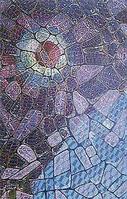Anthea McGibbon, Gleaner Writer

Deryck Campbell's 'Wee Wee' and Paula Daley's 'Almost Biology'.- photos by Anthea McGibbon/Sub Editor
PAULA Daley and Deryck Campbell, two Jamaican artists, put Jamaica on the contemporary edge with their departure from traditional expression with separate exhibitions recently, at Mutual Gallery and Harmony Hall in Ocho Rios.
They both excel in their abstract expression of what's real distinct in references used and the ultimate techniques explored, the final products of Daley and Campbell are clever illusions.
Daley's show at the Mutual Gallery, titled 'The Journey Continues', offers illusions of varying imagery, while Campbell's 'Ragged Sheets' is strategic in the varying images depicted.
They both, however, highlight their experiences in the Maryland/ Washington DC area - Paula as a master's degree student and Campbell as a 35-plus-year resident.
Daley's work reiterates the need for art colleges - to develop and sharpen the artist's mind. Daley is a teacher at the Edna Manley College of the Visual and Performing Arts in St. Andrew. In 'The Journey Continues' she offers no one theory, but demonstrates her 'innate love for detail, structure and purpose'.
The exhibition, which is her first major show since completing her master's at the Maryland College of Art (MICA), opened on February 1, and continues to February 27.
Controversial interpretations
Her canvassed acrylics take us on her journeys through Kingston and Maryland. However, there is more to the intricately detailed designs. The pieces extract controversial interpretations, adding dimension to her explanation that they are physical and psychological impressions of her travels.
'Enter the Unknown', the Chronicle series, 'Landing Strip', achieved the overall objective in narrating her journey from a Caribbean island to the 'winters' of Maryland for her summer master's studies. In 'Almost Biology', osmosis is addressed; how she survived the Maryland 'winters' is brilliantly illustrated in 'Winterscape'.
Former director of studies at the Edna Manley College, Hope Wheeler, who studied alongside Paula, was guest speaker at the opening. As one of Daley's personal critic and guides, Wheeler described her colleague as "honest, always curious and unselfish."
In her critique, Wheeler highlighted the varying shapes, patterns and rhythm especially in the fictional landscapes, as she described the collection as "a virus forming an intricate web, juxtaposed again to imitate the real world."
The understanding of drawing between paintings and sculptor comes to the fore in the eclectic works of Derryck Campbell, who studied at the University of the District of Columbia. In his second local show, which runs until February 28, he portrays his exploration beyond traditional techniques and styles.
Anthea, Campbell's wife of 30 years, highlights this as the rationale behind the exhibition's variety of techniques and styles. The artist's sense of humour complements his sharp eye for detail and high quality.
Style and uniformity
Campbell transforms his personality in his elegant intertwining of hidden images within the paintings, and the multi-purposes of the interchangeable furniture the collection features several techniques, there is uniformity in the artist's styles.
Art buff, Dorothea Whiteborne, said she collects art that is not "wishy washy". She dismissed criticism that Campbell's works are too varied, and expressed her preference for the smaller pieces, which are well-defined and captures, for her, "his sense of fun".
'Happy Hour', with its thicker application of oils, was one of the pieces which made an impression on her.
Overall, the works are done in varying oil mediums and mostly on vellum, but several techniques from washes to drawings or combinations are employed. Defying Jamaican stereotypes, Campbell is daring in his washed-over sketches such as 'Private Dancer', 'Lazy Girl', 'Ragged Sheets' which highlight intimacy in semi-abstract designs.
His 'Wee Wee' and 'Butt Stop' rub against the grain of Jamaican art; the subject is as radical as the exploration of techniques and styles. In 'Wee Wee', a boy is held by his mother as he urinates on a garbage bin, and in 'Butt Stop, a skimpily-clad woman bends over, pretending to be unaware of the commotion her exposed posterior has caused.
'The Model' was the most controversial piece, and enhanced Campbell's diversity it depicts a seated painter examining his standing model, it could easily have been a man or a woman, it has multiple interpretations. As time went by, the number of figures actually seen in the largely blue oil wash on vellum increased to four.
Evidently, the ideal that art is about personal interaction is one cause of the artist's work.
Anthea McGibbon, a graduate of the Edna Manley College of the Visual and Performing Arts, has over 10 years experience in the fields of visual arts and journalism. Contact her at islandartattack@yahoo.co.uk or anthea.mcgibbon@gleanerjm.com

